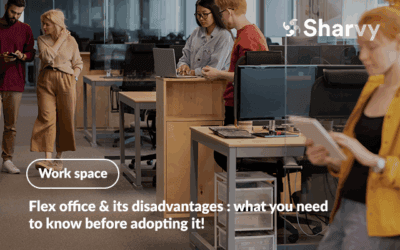Without doubt, the Covid-19 crisis has disrupted established routines. For several months, we suddenly changed our way of working. As a result, many companies have introduced hybrid working for their employees in order to adapt to the exceptional situation of the health crisis we were experiencing.
However, what is it? In the same way, how is it implemented? What are the benefits? Similarly, is it just a passing trend or a new standard for businesses? Find all the answers in this article!
What is hybrid work?
Hybrid working means an employee alternates between days spent in the office and days spent teleworking. In addition, each company is free to define the rules of its teleworking policy. For example, today’s most common pattern is 2 days teleworking / 3 days on-site. From now on, each company must consider its hybrid working arrangements and explain them to its employees.
How to set it up?
First of all, it is essential for the company to survey its employees in order to know their wishes : do they all want to telework? Do they all have the possibility to do so (suitable space, computer equipment, etc.)? What rhythm suits them best? The idea is to conduct a small survey among employees in order to propose a hybrid work policy that will meet their needs and that will therefore be easily accepted by all.
Once this stage has been completed and the policy defined, it is important to communicate the changes to managers and employees. Management will automatically be affected, and it is essential to maintain trust between the teams and their manager. It is not a question of controlling people too much at a distance, or on the contrary, of abandoning them in favour of those in person.
Furthermore, a good implementation of hybrid work in a company depends on providing employees with the necessary equipment and tools to carry out their mission from any location. Among the most important tools are those for :
- Communication and meetings with colleagues, in order to maintain the social link and exchange easily,
- Sharing documents, such as the various shared drives,
- Reservation of spaces, like desk booking (parking space, office, corpoworking, hot desking spaces and other resources), as Sharvy does.
To help you, download our free checklist!
For what benefits?
The implementation of hybrid working in organisations has many advantages, both for the employee and for the company.
1. Benefits for the employee.
- Better efficiency : depending on the assignment, it is sometimes more efficient to telework. Indeed, the employee will be less disturbed and distracted than when he/she is surrounded by several colleagues, he/she will be able to concentrate fully on his/her tasks.
- A better balance between professional and personal life : thanks to teleworking, the employee has more time for leisure activities, can organise his working hours according to personal requirements.
- Reduced costs : teleworking employees save on travel costs. At the same time, they save on lunches, for example.
- Less stress : by eliminating one or more days per week of transport, the journey which can be a source of stress and annoyance. Commuting is regularly a source of stress and annoyance. According to a study by ADEME, 3 out of 5 working people work outside their hometown. As a result, the distance between home and work is, on average, 15km, or around 45 minutes of transport per day. By allowing flexible working within your company, for example, by allowing two days of teleworking per week, you can considerably improve your employees well-being and quality of life. In fact, according to a study by Owl Labs, 84% of employees shared that working remotely would make them happier and the QWL increase.
1. Benefits for the company.
- A better employer brand : you will considerably improve your employer brand. Your company will be more attractive, especially to young talent! As a result, it adapts to current trends and the new expectations of candidates.
- Saving space and money : by definition, some employees are off-site every day. This allows the company to move from a system where everyone has an office to a more flexible approach. As a result, workstations are no longer designated by name (thanks to the introduction of desk sharing and flex office). This gain in space and, therefore, m² can lead to a reduction in costs. However, remember that you must take desk sharing literally by pooling workstations to take full advantage of this benefit. So, if your company has around fifteen employees, you should only offer about ten individual workstations. To do this, it’s all a question of organizing and managing the workstations internally on a rota basis. In this way, it becomes possible to rent smaller but higher quality premises, enhanced by services that improve your employees’ day-to-day lives.
- Creating new spaces : the gain in workspace space can enable the company to create new spaces—for example, breakout rooms, cafeterias, hot desking areas, corpoworking spaces, etc.). As a result, your offices get a whole new look and become resolutely more collaborative, creative, and user-friendly! The hidden idea is that each space in your company should respond to a given activity. There’s no need to carry out significant work, it’s more a question of optimizing and fitting varied, evolving, and modular spaces.
Fad or new standard?
According to a study by Cadremploi and the Boston Consulting Group, 78% of employees today favour this way of working. This figure has been rising steadily since the Covid-19 health crisis, which changed the way millions of people work.
Ways of working are changing and the future of work seems to be becoming flexible. Hybrid working seems to be becoming part of people’s habits. And companies are obliged to adapt in order to remain attractive to candidates and to keep their talents. More than a simple fashion effect following the health crisis, hybrid work and the working methods it generates, such as the flex office, are gradually becoming established in companies and seem to be continuing to evolve thanks to its growing adoption.
In conclusion
Ultimately, hybrid work is proving to be much more than just a passing trend, gradually becoming a new norm in work organization. With its positive impact on productivity, flexibility, and workplace well-being, it is transforming work environments into more collaborative spaces that cater to the contemporary needs of nomadic employees. For companies, adopting this model is not only a response to current challenges but also a strategic lever to attract and retain talent while optimizing their office spaces.
Want to learn more? Check out our latest articles!
Flex office & its disadvantages : what you need to know before adopting it!
What is the flex office? How does it work? What are its drawbacks and how can you overcome them? Find the answers in this article!
The office as a branding tool : how can it reflect your corporate culture?
Is the office an underestimated branding tool? How can your spaces embody your culture & reinforce your brand image? Focus!
Flexible office solutions : how to adapt them to all generations ?
How can flexible office solutions adapt to the needs of different generations? What are the best strategies to implement? Focus!
Subscribe to our newsletter!
Resources
Contact us
+44 117 463 6990





